
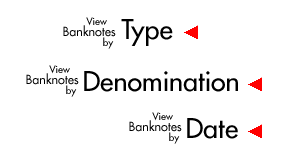
As of 1 March 2023, the number of Ploughman notes recorded by verified serial number in the PSS Currency Commission Consolidated Bank Note Population Report is: One Pound, 2,598; Five Pound, 920; Ten Pound, 334. A detailed breakdown of these data is available on the Consolidated Bank Note Population Report page.
Results of the Ploughman Scan Survey and a more detailed breakdown of the Ploughman note population are posted periodically on the Ploughman Note Population Report board.
The board also has valuations of Ploughman notes.
Following the recommendations of the report in 1926 of the Banking Commission which had been created to consider the future of Irish currency, the Currency Act, 1927 [3] provided for the establishment of the Currency Commission Ireland and gave it powers to issue, control and manage a new Irish currency of Legal Tender Notes.
In addition, the Consolidated Bank Note issue was created as a means to replace the all-Ireland General Issue banknotes in circulation throughout Ireland for over 80 years, and which remained in use in the Irish Free State since the state's creation in 1922. The general issue banknotes were issued by the six Irish Joint Stock banks that had the right of note issue under British rule in accordance with the Bankers (Ireland) Act 1845 [4].
Each bank had its own design of General Note Issue, which was to be split between the Irish Free State as Consolidated Bank Notes (being 'consolidated' into a uniform design note issue, following the style of United States National Bank Notes under the US Federal Reserve system) and the new Northern Ireland Issue of the banks, which retained separate designs for each bank. This division of the currency is covered in detail under the Partition of Irish Currencies, and took place on an appointed day, 6 May 1929. This is the first date of issue on all the denominations of the Ploughman notes, and the earliest date of issue on many Northern Ireland Issue notes.
Although it is believed that a design was prepared for a 10 shilling Consolidated Bank Note, the denomination was not included in the series, despite the introduction of a Legal Tender 10 Shilling Note in 1928.
The decision to not have a 10 shilling denomination may have been related to its not being in use by any of the banks which issued notes.
Thus, six denominations of Consolidated Bank Notes were made available to the banks: 1 Pound - 5 Pounds - 10 Pounds - 20 Pounds - 50 Pounds - 100 Pounds.
The Consolidated Bank Note issue extended the right of note issue to all eight joint stock commercial banks operating within the Irish Free State at the time.
One of the banks which had issued old all-Ireland notes prior to 1922, the Belfast Banking Company, withdrew from the Irish Free State, selling all its branches to the Royal Bank of Ireland. The Belfast Banking Company continued to issue notes in Northern Ireland only from 1922 onwards.
Consolidated Bank Notes were regulated by the Currency Commission, and were never Legal Tender, merely a promise to pay such.
The Central Bank Act, 1942 established the The Central Bank of Ireland in place of the Currency Commission and provided for the withdrawal of the right of note issue from the commercial banks, leaving the Series A Legal Tender Notes the only notes issued in Ireland.
The Consolidated Banknote issue commenced on 6 May 1929 and ceased on 31 December 1953 when the total aggregate amount permissible of notes of all the banks reached zero after a steady period of reduction.
The iconic Ploughman notes had circulated actively for just 24 years.
Ploughman Note Proofs
Currency Commission Ploughman Specimen Notes
Thomas De La Rue Ploughman Specimen Notes
View by Type: 8 Banks - Nineteen Types of Consolidated Bank Notes by signature variation.
View by Denomination - An example of each denomination for all Types.
View by Date - An image of a banknote of every date for which an example has been seen.

Bank of Ireland £1 notes are by far the most common notes, accounting for 18% of all Ploughman notes seen, and 29% of all £1 notes recorded.
The rarest Ploughman note by bank is the Northern Bank £10 note (seven examples recorded), and the rarest note by signature Type is the Provincial Bank of Ireland £10 note, with Kennedy signature (three examples recorded).
One Ploughman error note with missing serial numbers has been recorded.
Relative rarities of the denominations of the banks with respect to each other. This relative rarity indicator is based on the results of the Ploughman Scan Survey results.
£1: BoI <<< Nat < M&L < (RB) = PBI < HiB < UB << Nor
£5: (Nat) < PBI = [BoI] = M&L = HiB < UB < RB < Nor
£10: [M&L] = PBI = Nat < HiB < UB = RB < BoI << Nor
The Ploughman Scan Survey (PSS) is a continuous survey the scope of which is to record all the surviving Ploughman notes. Reports on the progress of PSS are posted over on the site forum.
Royal Bank £1 notes and National Bank £5 notes are of equivalent rarity to each other, and Bank of Ireland £5 notes are of equivalent rarity to Munster and Leinster Bank £10 notes.
The figures for the amount allocated to each of the Associated Banks were as follows [Moynihan 1975, p. 48]:
The Bank of Ireland Ltd. £1,760,000*
The Hibernian Bank Ltd. £439,000
The Munster & Leinster Bank Ltd. £852,000
The National Bank Ltd. £1,365,000
The Northern Bank Ltd. £243,000
The Provincial Bank of Ireland Ltd. £649,000
The Royal Bank of Ireland Ltd. £273,000
The Ulster Bank Ltd. £419,000
Total £6,000,000
*The Bank of Ireland total includes the £55,000 that was allocated to the National Land Bank, which was taken over by Bank of Ireland in 1926 [Moynihan 1975, p. 49], and had its name changed to the National City Bank [BoI].
Note: the dimensions of ploughman notes tended to vary by a few millimetres, depending on the cut.
£1 Note, 151 x 84;
£5 Note, 165 x 92 mm;
£10 Note, 191 x 108 mm;
£20 Note, 203 x 114 mm;
£50 Note, 203 x 114 mm;
£100 Note, 203 x 114 mm.
Blue and red security fibres were incorporated into the face side of the paper used for the Consolidated Bank Notes. A strip of fibres 2.5 cm wide are embedded in the face of each banknote, which runs from top to bottom in the centre of the note.

Detail of the security fibres embedded in the face of each Consolidated Banknote.
This is a security feature also seen on banknotes of some other countries of the same era, for example the 1935 and 1936 issues of the Farmers Bank of China which were printed by De La Rue.

Security fibre strip running down the centre of a Farmers Bank of China 50 Cents 1936 compared with that on a 1931 Ploughman Pound note [Farmers Bank of China 50 Cents from noonans, 28 Aug 2024, Lot 209, Farmers Bank of China, 50 Cents, 1936.]
The Consolidated Bank Notes were printed on watermarked paper by Thomas De La Rue Limited on watermarked paper manufactured by Portals Limited. There are four watermarks on each banknote, one located in each corner.
On £1, £5, and £10 notes the watermarks consisted of a harp, the denomination, the letters 'CBN', and shamrock.
The watermarks on £20, £50, and £100 denominations were similar, but with a second instance of CBN in place of the denomination.
The watermarks are quite easy to see when a note is viewed from the reverse or held up to light, as illustrated.

Watermarks on a Ploughman Ten Pound note

Ploughman Five Pound note watermarks


Watermarks on a Ploughman Twenty Pound note


Watermarks on a Ploughman One Hundred Pound note
Specimens of Consolidated banknotes were produced in the colours of issued notes with the Bank of Ireland title. Ploughman specimen notes with other bank titles have never been seen and are unlikely. However, some proofs produced during the design process did use other bank names.
Ploughman specimen notes in non-standard colours were also produced by De La Rue, probably in the 1930s, for use as examples of the company's printing.
Proofs also exist in various colours.
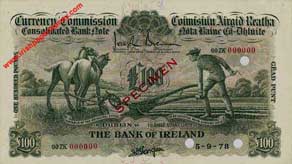
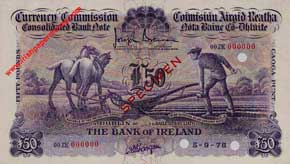
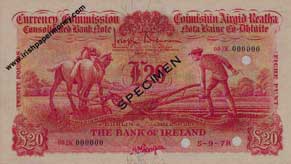
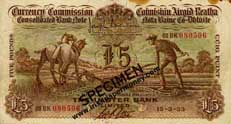

1 Pound Ploughman
5 Pounds Ploughman
10 Pounds Ploughman
20 Pounds Ploughman
50 Pounds Ploughman
100 Pounds Ploughman
General references
1. Moynihan, Dr. M. 'Currency and Central Banking in Ireland 1922–1960', Gill & Macmillan and The Central Bank of Ireland, 1975.
2. www.bankofireland.com/about-bank-of-ireland/about-the-group/bank-of-ireland-history/
3. Currency Act (1927). https://www.irishstatutebook.ie/eli/1927/act/32/enacted/en/html?q=currency+act&years=1927
4. Bankers (Ireland) Act 1845. <https://www.irishstatutebook.ie/eli/1845/act/37/enacted/en/print> [Last accessed 27.11.21].
![]() Page under active revision. Last updated 18.09.24.
Page under active revision. Last updated 18.09.24.